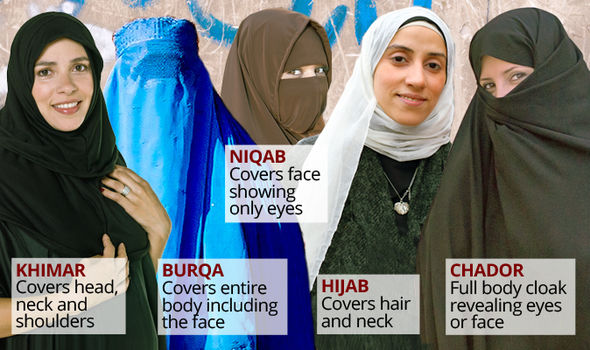The Great War
Published on 30 Dec 2017Play Warthunder For Free:
https://warthunder.com/play4free?r=greatwarIndy takes a look at the Sopwith Snipe and meets Trevor who shows us the typical gear of a WW1 pilot.
December 31, 2017
The Sopwith Snipe – WW1 Pilot’s Gear I THE GREAT WAR Special
A contrarian view of hijabs, niqabs, and burqas
Western views of full-coverage clothing, including hijabs, niqabs, and burqas, may be concealing a hidden benefit to those who choose to wear such clothes voluntarily:
Hijabs, niqabs, and burqas — different sorts of coverings worn by Islamic women — are divisive apparel in the West, associated with patriarchal oppression, cultural outsiders, and even suicide bombers. Yet few accounts actually discuss the experiences of the women wearing the veils, and the freedom and anonymity coverings can afford if worn voluntarily.
Born in Pakistan and educated in America, Rafia Zakaria is the author of Veil, a new book which explores the history and shifting meanings of female coverings in Islamic countries and Western secular society. In a wide-ranging conversation, she talks with Reason‘s Nick Gillespie about the theological underpinnings of veils, their use as a means of controlling female sexuality, and how they have become markers of socio-economic status and virtue signaling.
Veils present a particular conflict for Western feminists. On the one hand, veils — especially burqas — are emblematic of regimes that are particularly oppressive to women. Feminists and others have moved to ban the wearing of veils in public in the name of female empowerment. But if a Muslim women wants to wear one, is she endorsing patriarchy and setting back the women’s rights movement or simply owning her own choices, especially in a culture that might itself be anti-Islamic?
Who Invented Hawaiian Pizza?
Today I Found Out
Published on 4 Dec 2017In this video:
On June 8, 2017, Greek-born, Canadian-bred pizza maker Sam Panopoulos died. His career slinging pies was rather unremarkable save for one notable thing – he was the inventor of the popular, yet infamous pineapple-topped “Hawaiian Pizza,” named as such because of the brand of canned fruit he used. Loved by some and hated by others, the sweet and salty pizza is so controversial that it once triggered an argument between friendly nations. While such arguments rage on both sides of it being a delicacy or an abomination, the fact is that the Hawaiian pizza is actually not Hawaiian – it’s Canadian. Here now is the story of pizza and the man who decided to add pineapples to it.
Want the text version?: http://www.todayifoundout.com/index.p…
QotD: The rise of the man-child
I just turned 51, and a disturbingly large percentage of men in their twenties and thirties seem like spoiled narcissistic man-children to me. I thought for a while that this might mean I was turning into the sort of crusty old fart I laughed at when I was twenty-five, until I noticed that the percentage of man-children varied a great deal depending on my social context.
At the martial-arts school where I’m training, zero to not much. Even the teenage boys there are pretty manly, on the whole – not surprising, since manliness is very nearly defined by stoicism and grace under pressure, and a martial-arts school should teach those things if it teaches nothing else. Anywhere firearms are worn or displayed openly, ditto — go to a tactical-shooting match, for example, and you’ll see even prepubescent boys (and, though rarely, some girls) exemplifying quiet manliness in a very heartening degree.
On the other hand…when I go to places where people are talking rather than doing, the percentage of man-children rises. Occasionally my wife Cathy and I go to screenings at the Bryn Mawr Film institute, most recently to see Sergei Bodrov’s The Mongol; it’s pretty much wall-to-wall man-children there, at least in the space not occupied by middle-aged women. If our sample is representative, my wife is manlier than the average male art-film buff.
How does one tell? The man-child projects a simultaneous sense of not being comfortable in his own skin and perpetually on display to others. He’s twitchy, approval-seeking, and doesn’t know when to shut up. He’s never been tested to anywhere near the limits of his physical or moral courage, and deep within himself he knows that because of this he is weak. Unproven. Not really a man. And it shows in a lot of little ways – posture, gaze patterns, that sort of thing. He’ll overreact to small challenges and freeze or crumble under big ones.
One of the things this culture badly needs is a set of manhood ordeals. Unlike the tribal societies of the past, we’re too various for one size to fit all — but to reliably turn boys into men (or, to put it in more fashionable terms, to help them become mature and inner-directed) you need to put them under stress in a way that, except for the small percentage that go through military boot camps, we basically don’t any more.
Instead, we prolong adolescence into the twenties and thirties. With dolorous consequences for everyone…
Eric S. Raymond, “Where the men are”, Armed and Dangerous, 2008-12-15.




